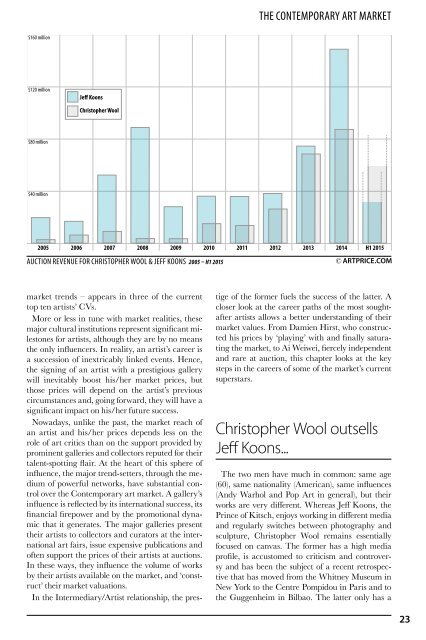THE contemporary
mMjqAT
mMjqAT
You also want an ePaper? Increase the reach of your titles
YUMPU automatically turns print PDFs into web optimized ePapers that Google loves.
The <strong>contemporary</strong> art market<br />
$160 million<br />
$120 million<br />
Jeff Koons<br />
Christopher Wool<br />
$80 million<br />
$40 million<br />
2005 2006 2007 2008 2009 2010 2011 2012 2013 2014 H1 2015<br />
Auction Revenue for Christopher Wool & Jeff Koons 2005 – H1 2015<br />
© ARTPRICE.COM<br />
market trends – appears in three of the current<br />
top ten artists’ CVs.<br />
More or less in tune with market realities, these<br />
major cultural institutions represent significant milestones<br />
for artists, although they are by no means<br />
the only influencers. In reality, an artist’s career is<br />
a succession of inextricably linked events. Hence,<br />
the signing of an artist with a prestigious gallery<br />
will inevitably boost his/her market prices, but<br />
those prices will depend on the artist’s previous<br />
circumstances and, going forward, they will have a<br />
significant impact on his/her future success.<br />
Nowadays, unlike the past, the market reach of<br />
an artist and his/her prices depends less on the<br />
role of art critics than on the support provided by<br />
prominent galleries and collectors reputed for their<br />
talent-spotting flair. At the heart of this sphere of<br />
influence, the major trend-setters, through the medium<br />
of powerful networks, have substantial control<br />
over the Contemporary art market. A gallery’s<br />
influence is reflected by its international success, its<br />
financial firepower and by the promotional dynamic<br />
that it generates. The major galleries present<br />
their artists to collectors and curators at the international<br />
art fairs, issue expensive publications and<br />
often support the prices of their artists at auctions.<br />
In these ways, they influence the volume of works<br />
by their artists available on the market, and ‘construct’<br />
their market valuations.<br />
In the Intermediary/Artist relationship, the prestige<br />
of the former fuels the success of the latter. A<br />
closer look at the career paths of the most soughtafter<br />
artists allows a better understanding of their<br />
market values. From Damien Hirst, who constructed<br />
his prices by ‘playing’ with and finally saturating<br />
the market, to Ai Weiwei, fiercely independent<br />
and rare at auction, this chapter looks at the key<br />
steps in the careers of some of the market’s current<br />
superstars.<br />
Christopher Wool outsells<br />
Jeff Koons...<br />
The two men have much in common: same age<br />
(60), same nationality (American), same influences<br />
(Andy Warhol and Pop Art in general), but their<br />
works are very different. Whereas Jeff Koons, the<br />
Prince of Kitsch, enjoys working in different media<br />
and regularly switches between photography and<br />
sculpture, Christopher Wool remains essentially<br />
focused on canvas. The former has a high media<br />
profile, is accustomed to criticism and controversy<br />
and has been the subject of a recent retrospective<br />
that has moved from the Whitney Museum in<br />
New York to the Centre Pompidou in Paris and to<br />
the Guggenheim in Bilbao. The latter only has a<br />
23


